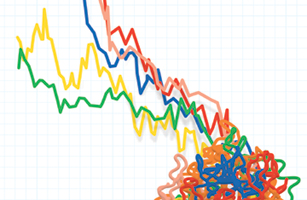
When you're looking for a way to describe the global economy, the thing that comes to mind is a mountain climber. High on a peak, he sees an inviting gully that seems to lead to the top. He starts scrambling, easily finds holds for his hands and feet, basks in the thin sunshine. Then the gully gets steeper, tougher and narrower; thunderclouds gather overhead. Soon our adventurer, perched on a ledge with nothing below but air, realizes he's stuck. At which point, this thought occurs: knowing precisely how he got into such a fix is an interesting question, one that he will enjoy discussing with fellow climbers at that nice bar in the valley. But the important thing right now is to get down. In one piece.
At last week's annual meeting of the World Economic Forum in Davos, there was no shortage of explanations for how the global economy had got into such a mess. Some were simple: bankers (and their clients, to be fair) were both stupid and greedy. Some were psycho- statistical: the inherent uncertainty of life had engendered an irrationality among economic decision makers. Some were historical: empires always overreach, in the process running up ruinous debts that must one day be paid. (See pictures of the global financial crisis).
Two Crises, Linked
The best explanations were comprehensive. Not the least of the pleasures of Davos was listening to the Premier of the People's Republic of China (albeit a man who claims to read and reread Adam Smith) on what had gone wrong. "The crisis," said Wen Jiabao, "is attributable to a variety of factors and the major ones are: inappropriate macroeconomic policies of some economies and their unsustainable model of development characterized by prolonged low savings and high consumption; excessive expansion of financial institutions in the blind pursuit of profit; lack of self-
discipline among financial institutions and rating agencies and the ensuing distortion of risk information and asset pricing; and the failure of financial supervision and regulation to keep up with financial innovations, which allowed the risks of financial derivatives to build and spread." That pretty much gets it.
As George Santayana said, those who cannot remember the past are condemned to repeat it. But right now we can leave history to one side. Blaming this bank or that, this regulator or the other guy, my nation or yours, is somewhat beside the point. The thing to do now is to find a way out of the global economic catastrophe, because the scale of it is truly frightening.
In essence, the world is having to deal with two linked crises at the same time. The narrower one is a consequence of the collapse of the U.S. housing market. This put pressure on bankers, both in the U.S. and elsewhere, who held toxic assets supposedly backed by real estate but for which there was no genuine market or price. And it squeezed U.S. consumers, who for a generation had been the spendthrift engine of the global economy, but who could no longer use their homes as piggy banks. The broader one is a function of massive global imbalances between debtor and creditor nations that have developed over the last generation. The U.S., in particular, has run up huge debts; Asian nations, led by China, have become enormous pools of savings and reserves. One day, those imbalances will have to be unwound, preferably by fundamental changes to domestic policy that encourage saving (in the U.S.) and spending (in China).
In the developed world, as the credit crunch bites, economies are heading for the worst recession since at least the early 1980s. As demand contracts in the rich world, export-oriented economies, especially in east Asia, are hitting a wall. Production in China's manufacturing sector fell for the sixth straight month in January, according to the financial services firm CLSA. Taiwan, a key center of the high-tech industry, probably slipped into recession in the fourth quarter of 2008.